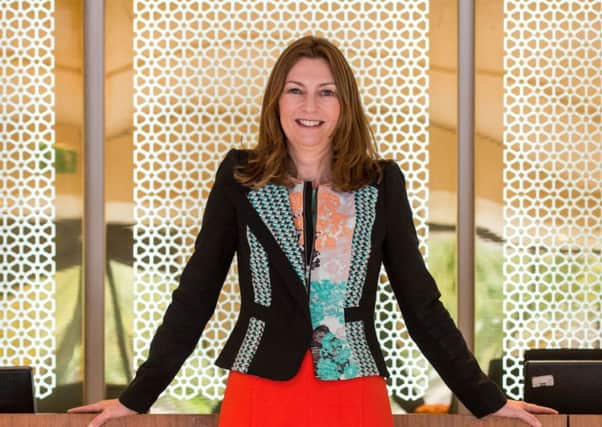Interview: Anne Richards, Aberdeen Asset Management


Now global chief investment officer at Aberdeen Asset Management, Richards found herself drawn towards a career that moved at a faster pace than the search for the elusive Higgs boson, which was eventually discovered two years ago – half a century after Professor Peter Higgs developed his theory about how particles gain their mass.
While studying electronics and electrical engineering at the University of Edinburgh, Richards embarked on a summer placement at the European Organisation for Nuclear Research – better known as Cern – and says the experience was “just fantastic”.
Advertisement
Hide AdAdvertisement
Hide Ad“I left Edinburgh in the early 1980s, when Scotland was at the nadir of its industrial relations and went to this halcyon land where the sun shone all summer,” she adds. After graduating from Edinburgh, she successfully applied for a research fellowship with Cern and headed back to Geneva.
There she worked on the predecessor of the Large Hadron Collider (LHC) as physicists narrowed down their hunt for the mooted Higgs boson – often called the “God particle”, although those in the scientific community dislike the term. The forerunner to the LHC was the Large Electron-Positron (LEP) collider, which was switched on in 1989, sending bursts of electrons and positrons hurtling towards each other around a 16.8 mile circular tunnel beneath the Franco-Swiss border.
Richards worked at Cern about three years before the LEP was activated, part of a team that was tasked with making sure the beams of particles were kept apart until the time came to smash them together to create their subatomic building blocks. Because they are being sent in opposite directions, the electrons and positrons would crash into each other before reaching the required speed unless they had a “passing place”, Richards explains.
“So I worked on the control system for the bit of kit – the high-voltage electrostatic synchronous discharge switch – that effectively made the lay-by.
“Positively-charged particles were drawn down to the negatively-charged plate, and vice versa, until the moment you wanted them to collide and you would switch off the electric charge. That’s when you get the collision.”
Although the LEP did not discover the Higgs boson, Richards said the device “told us lots of information about where it wasn’t”, so in 2000 the particle accelerator was dismantled and its tunnel now hosts the LHC.
Richards left Cern in 1988, but she is still involved with the facility, which is celebrating its 60th anniversary this year. She chairs its charitable foundation, which aims to make science more engaging to wider society through outreach work with schools and universities. She also sits on the council of the Duchy of Lancaster – the Queen’s rural estate that also has a sizeable commercial property portfolio in London – and is vice-convener of the court of Edinburgh University.
After returning to the UK, she worked for a firm of engineering and technology consultants in Cambridge while studying for a diploma in accounting and finance in her spare time “and I enjoyed that more than I expected to”. So in 1991 she enrolled at the Insead business school near Paris to earn her MBA, and in the first term discovered an interest in finance and markets.
Advertisement
Hide AdAdvertisement
Hide Ad“Suddenly this whole new world opened up, which was constantly changing. I fell in love with the vibrancy; there’s always something interesting to look at or read.”
After graduating from Insead, she “fell into fund management by accident” and started as an engineering analyst with Alliance Capital. “I spent a lot of time going down gold mines, visiting shop floors and canning plants. I was always a practical academic, and that works in fund management.”
But Richards says she quickly realised that she wanted to move “one step closer to the money”, so joined JP Morgan Investment Management in 1994, managing European and UK portfolios, before being headhunted by Mercury Asset Management five years later.
Then Edinburgh Fund Managers (EFM) came knocking, and Richards joined as chief investment officer in 2002, just six weeks before a shareholder revolt that would lead to a boardroom clearout. Richards and chief operating officer Rod MacRae – now group head of risk at Aberdeen – were the only directors left.
“It very quickly went from being an interesting challenge to all hands to the pumps,” she laughs. EFM was acquired by Aberdeen the following year.
Aberdeen is now in the process of integrating Scottish Widows Investment Partnership (Swip), having completed its £550 million acquisition from Lloyds Banking Group in May. The deal is the group’s largest to date, but saw about 150 people made redundant.
In a trading update last week, Aberdeen said the integration of Swip was progressing “on schedule and as expected” as it revealed assets under management had grown 3 per cent to £331.2 billion over the two months to 31 August.
Richards, ever the engineer, says the combination of the two firms’ systems is a “big and complex” undertaking, but the migration of front-office operations is going “encouragingly smoothly”.
30 SECOND CV
Advertisement
Hide AdAdvertisement
Hide AdJob: Global chief investment officer, Aberdeen Asset Management
Born: Edinburgh
Education: Royal High School; University of Edinburgh; Insead
Ambition while at school: To be a doctor, before realising
I wanted to be an engineer
Favourite mode of transport: Walking
Car you drive: Kia Picanto
Music: I have omnivorous taste
Can’t live without: Family, but my kids would say my iPad
Favourite place: The top of a mountain
Who inspires you? Survivors
What makes you angry? Injustice
Best thing about your job: The people – I work with a great team